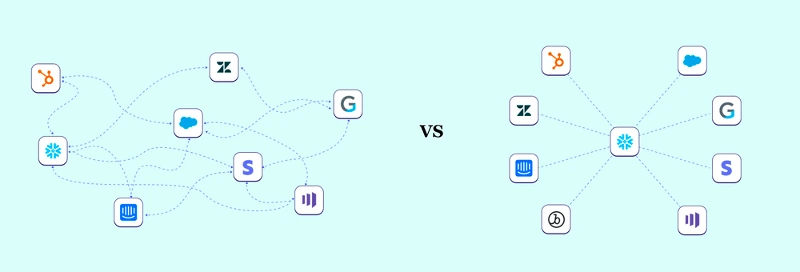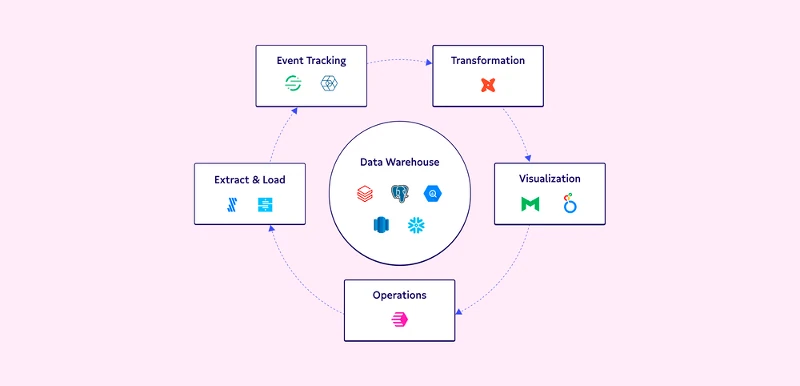TL;DR: If you’re just looking for a quick definition we got you. As the pioneers of the approach, and the world’s first Operational Analytics Platform, we define it as follows:
Operational Analytics is an approach centered on building a shared understanding between teams based on trusted, highly-accessible data from your warehouse.
Note: This is the new and improved version of our What is Operational Analytics? resource. If you'd like to revisit the original and see how far the modern data space has come, you find it here.
Whether you’re working on a data team, inside of an ops team like marketing, sales, or customer success, or on the receiving end of less-than-stellar customer support from your favorite apps, you know the importance of fresh, accurate data.
This information, when readily available to the teams supporting customers every day, is the difference between memorable, enjoyable service that builds customer loyalty and a frustrating experience at every touchpoint.
Over the last few years, the data industry has exploded with tools and companies aiming to address data quality, freshness, and availability pain points. Unfortunately, many of them have failed on a fundamental level to fix anything at scale:
- Case-by-case app integrations quickly become too complex to understand and difficult to maintain
- Custom code is expensive and maintenance eats up valuable engineering time
- Customer data platforms (CDPs) lack critical visibility and only serve a handful of teams and use cases
- Integration Platforms as a Service (IPaaS) and automation tools lack structure
- Business Intelligence (BI) tools promise action, but only with heavy human labor
In short, existing tooling has put companies between a rock and a hard place, forced to choose between trusting their data and being able to take quick action on it.
So, what’s next? If all these tools and the ever-expanding data industry haven’t solved the data freshness and democratization problem, what can companies do?
The answer is: Operational Analytics.
So, what is Operational Analytics?
We promise this isn’t another “digital transformation” trend.
Operational Analytics lets you sync data directly from your data warehouse into the frontline tools (like Salesforce, Hubspot, and Marketo) your team relies on every day to drive action, not just insights. It means better automation, better understanding between cross-functional teams, and more effective workflows.
The best part? Operational Analytics is a tactical approach–both in terms of tooling and process–that you can start implementing at your organization today to do more with your data (and spend less time worrying about it along the way).
Operational Analytics and the modern data stack
Operational Analytics isn’t about reinventing the modern data stack you’ve worked so hard to invest in. It’s about using the tools within that stack better and more effectively toward a common goal: empowering the data team to better serve data consumers.
When Census first started in 2018 as the first reverse ETL tool on the market, companies were just starting to focus on enabling PLG with data (see the early success of Figma, Canva, and Notion). However, while many of these organizations were implementing powerful tools like Fivetran, dbt, Snowflake, and others, many were still relying on a complex web of point-to-point integrations that tripped up more progress than it fueled.
This all shifted when companies started to look at their data warehouse as a single source of truth, a philosophy we’ve built around since the start. With the warehouse seated at the center of their stacks, companies could empower more analysts and use cases than ever before.

While this architecture shift has moved data maturity levels miles down the line, simply putting the warehouse at the heart of all data flows hasn’t solved everything. As we talked about at the beginning, you can do all the most advanced modeling and data processing in the world, but if you can’t ship that data across the last mile to your frontline teams, it doesn’t make a difference.
This is why we originally created our reverse ETL tool, to help data teams bridge the gap between their work and the needs of data consumers, effectively making Operational Analytics possible.
With the last mile of the data journey bridged, companies can unlock a truly virtuous cycle of data, from raw data to modeling to deployment into apps and back.

Now, the completion of this virtuous cycle of data comes with a champagne problem: More and more data consumers know the value of data, which means they’re asking for more and more data. This is where the process and practice part of Operational Analytics comes into play.
By borrowing from the world of DevOps, DataOps has offered companies a framework for treating data as a product to achieve Operational Analytics. This means data teams can apply the product development principles of the software engineering world–such as versioning, monitoring, testing, and continuous delivery–to their data pipelines (via an Operational Analytics Platform like Census).
This new genre of data tools closes the feedback loop that separated DataOps from DevOps and makes it possible for teams to deploy relatively real-time data and insights to core apps and services. - Boris Jabes, CEO at Census, The Operational Analytics Loop: From Raw Data to Models to Apps, and Back Again
When companies combine the advanced tooling of the modern data stack, including Operational Analytics Platforms, with the processes of the DataOps movement, they can revolutionize how they work with data.
Why invest in Operational Analytics?
Operational Analytics isn’t just a new tool to adopt, or a new pilot for one team in your org to try out. It’s about changing–organizationally–how you think about working with your data. OA lets you align the data and ops teams on what data means to the business, as well as ensure efficient data delivery using the modern tools already in your stack. And that takes some work (but we’re here to help every step of the way).
However, when you invest in Operational Analytics, you can achieve some truly amazing results:
- The ability to deliver trustworthy data and insight from one central hub (not just A to B, but A to everywhere).
- The ability to create a consistent picture for everybody in every tool.
- The ability to reach every one of your customers at any scale at just the right time.
- The ability to bridge the data gap and human gap between data and ops teams.
These outcomes are what’s made it possible for our customers to drive PLG at scale, craft personalized customer marketing for millions of users, and reduce cost per acquisition across all their campaigns.
Unlike traditional analytics (e.g. business intelligence), OA isn’t about just getting your data into another dashboard or report that requires hours of deliberation from your team to determine the next best action. Instead, OA fuels action by telling every frontline team in your business exactly what action they need to take next, all while capitalizing on the latest insights from your data team.
But don’t just take our word for it, here’s a breakdown of what Operational Analytics has made possible for industry-leading data, marketing, sales, and customer success teams.
What Operational Analytics means for the data team
As our CEO and Co-founder Boris Jabes has said for years: Operational Analytics means data teams are poised to eat the business, making every function within the company a data-driven one.
Operational Analytics isn’t just about helping data teams do less of the work they hate (e.g. custom integrations work), it’s about helping them become better strategic teams within the company and take the seat at the table they deserve.
With Operational Analytics, modern data teams at companies like Loom, Clearbit, and Canva have built a new legacy and culture around their work. Here are some of our favorite stories of data success:
- Data teams can use Operational Analytics to spend less time doing integration work and more time building cutting-edge models and doing interesting analyses.
- Data teams can use Operational Analytics to better advocate for the skills of their team and establish themselves as a key stakeholder.
- Data teams can use Operational Analytics to delight data consumers (and, ultimately, customers) and make it easier for everyone to get access to the data they need.
- Data teams can use Operational Analytics to provide fresher, more accurate data for everyone’s work.
- Data teams can use Operational Analytics to ensure they have total control of data pipelines from end to end.
The future of every industry relies on the data team. Operational Analytics ensures that those data experts inside your company can do their best work–and that everyone can benefit from it.
Operational Analytics for the marketing team
Your marketing campaigns are only as good as the data going in and out of them. With Operational Analytics, you can build campaigns that speak directly to the users and audiences who need your product most.
As we’ve seen with companies like Notion and Canva, access to truly data-driven marketing operations can make all the difference. Here’s how some of our most successful customers have improved their marketing ops with Operational Analytics:
- Successfully loaded data in Salesforce workflows to power lead scoring, MQLs, and PQLs
- Tapped into the full functionality of their existing tools (and able to start using shiny new tools they’ve always wanted to try)
- Driven better segmentation and personalization through actionable user data
- Embraced faster experimentation efforts through ad targeting and user propensity scoring
- Completely cut out their need for custom code and email CSV uploads
Innovative, effective marketing can’t happen if you’re tripped up by guesswork and days-old data. Even the best laid data-driven plans will dry up if you can’t get access to the data in question easily. Operational Analytics makes high-performing, high-ROI marketing campaigns that convert not just a possibility, but a reality.
Operational Analytics for the customer success team
Data is critical for customer success teams and often means the difference between being able to meet retention and adoption goals and watching customers slip away. By embracing Operational Analytics, data-driven companies like Loom, Bold Penguin, and Atrium have been able to achieve some truly inspiring outcomes, such as:
- Unlocking collaboration between customer success and sales to reach customers with a unified front.
- Creating account type and hierarchical ticket prioritization models.
- Making critical data truly self-serve for the customer success team.
- Reducing response times for common support issues from days to minutes.
And these are just the start. As our customers and Operational Analytics practitioners get better access to trustworthy data, the sky's the limit for what they can do with that data.
Operational Analytics for the sales team
Operational Analytics gives sales teams access to the data they need to not just convert customers, but build lasting, loyal relationships with them at every step of the sales journey.
After all, as any company embarking on PLG knows, it’s not just about optimizing one touchpoint, but ensuring every interaction with your customers is timed perfectly. Here’s how leading companies like Figma, Snowplow Analytics, and LogDNA have ensured they reach the right customers with the right message at the right time through Operational Analytics:
- By using an OA Platform to understand what features customers love most (and where each customer is in their lifecycle).
- By using OA to create lead scores with fresh, real-time data.
- By using OA to empower real-time sales forecasting in destinations like Google Sheets.
- By using OA to create a shared understanding of customers and the organizations they belong to.
- By using OA to give sales teams access to high-quality behavioral data in the tools they rely on.
When businesses can operationalize their data and serve it easily to sales teams, those teams can work smarter and faster to prioritize the companies and customers that matter most.
How to get started with Operational Analytics
Even the longest, most epic journeys start with a single step.
You don’t need to rearchitect your entire data stack to get started with Operational Analytics, you just need to identify your biggest data pain point today and get your data team and the ops team on the other side talking about their needs.
Want a quick project to get started? Sending metrics to Slack is an awesome way to kick off Operational Analytics at your company and lets you get actionable data in front of everyone in your business in real-time. This workflow makes it easy to celebrate new milestones or monitor issues before they become fires. And the best part is: Nobody has to go learn a new tool.
Need help with a use case that’s a little more complex? Sign up for a Demo of Census today and our team of experts will walk you through each step of your data journey. Or, if you're looking for support from your peers (and want to find some friends in data to learn from), check out our dedicated practitioners’ community: The Operational Analytics Club.

















